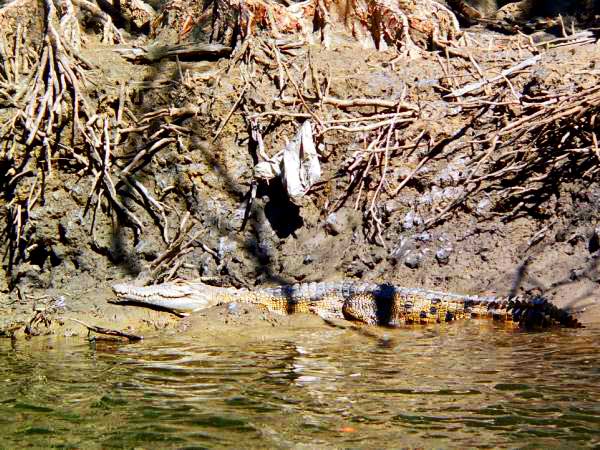Published in the Ocean Watch column, Honolulu Star-Advertiser © Susan Scott
July 6, 2007
Last week, I took a break from sailing in the cold rain and parked my boat in a small marina near Cairns. Such chilly temperatures, mid-50s to low 70s, are unusual here on Australia’s coral coast, and it’s all people talked about.
I didn’t mind, though. The boat was safe, the people were friendly and I’m in tropical Queensland, where I share my marina with crocodiles.
It’s true. Two official notices in the harbor say: “WARNING! ACHTUNG! Crocodiles inhabit this area — an attack may cause injury or death.” The notice goes on to give croc-wise advice: Stay away from the water’s edge, never clean fish near the shoreline and don’t linger while launching and retrieving boats.
Not all people would be thrilled to see such signs in their boat harbor, but I am. These are public education notices, one of several conservation strategies the Australian government is using to reduce conflict with people and, thereby, save their crocodiles.
Other management policies include stopping all trade in wild crocodile hides and strictly controlling hunting.
Unregulated hunting from the 1940s through the 1970s caused a drastic decline in croc numbers. Today, killing of crocodiles is prohibited in Australia, except for a small number by indigenous people.
The hunting ban caused a problem for landowners, who once shot large crocodiles lingering close to home. But the conservation plan included these people. Wildlife managers remove “problem crocodiles” from populated areas and take them to farms. There the big reptiles live in peace and do their part in sustainable-use programs.
Australia’s crocodile ranches are models of success. Since only about 1 percent of crocodile eggs make it to maturity on their own, landowners are allowed to collect eggs from wild nests and sell them to authorized facilities. There workers incubate the eggs and sell the hatchlings to crocodile farms. Croc farmers sell their animals for meat and skins.
Collecting eggs from nests in the wild sounds bad, but it’s brilliant. By making wild eggs valuable, people protect adults and their habitat. It’s also incentive to leave some eggs to hatch on their own, which will eventually produce more eggs.
It’s working. Researchers estimate 100,000 to 150,000 crocodiles, near pre-exploitation numbers, now live in northern Australia.
Saltwater crocs, known as salties here, are native throughout tropical Asia and South Pacific islands. In most other countries, though, croc numbers continue to dwindle.
I looked often for crocodiles around my marina with no luck. Then I learned that crocs don’t come out in cold, cloudy weather. The local newspaper reported that the low temperatures had crocodile biologists concerned. “Crocodiles have to get out in the sun to warm up so their digestion works,” a wildlife official said.
When the sun did appear, I sailed to Green Island, a national wildlife refuge I’ve long wanted to visit. And there were my crocs. One was 18 feet long. Its name is Cassius.
OK, my sightings were in a croc zoo there. The nicely managed facility emphasized education and preservation, and I enjoyed my visit.
Still I’d love to see one in the wild. I think. I’ll keep looking. Achtung!
UPDATE – per email from Susan to me (her sister) on 7/5/07:
“I went crocodile hunting in Bato today, up the river next to the marina. Here’s my grand picture prize. I nearly fell out of the dinghy when I saw it, because I had been going for hours and had about given up. Isn’t he a beauty? So colorful compared to the ones in the zoos. A fisherman came by in a runabout (scaring off my precious croc), but he told me that that was a SMALL one (I’d guess 4 or 5 feet) and that he’d seen a much bigger one earlier in the day. I’ll be out in Bato every day now until I leave.”
